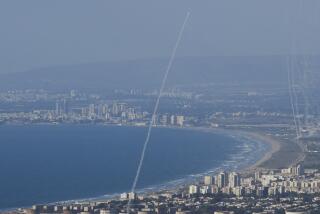U.S. Military Planners See Few Useful Beirut Options
WASHINGTON — The Reagan Administration’s military planners see few useful options for rescuing the hostages held by Shia Muslim hijackers in Lebanon.
The shadowy structure of the Shia organizations, the political chaos in Lebanon, the local population’s dislike of the United States and the lack of up-to-the-minute military intelligence on the crisis all make the job of planning a military strike difficult, in the view of experts in the Pentagon and elsewhere.
Officials refused Monday to discuss in detail any options under consideration or to shift from the longstanding Defense Department policy of refusing to disclose ship positions or the location of troop concentrations. But one Pentagon official acknowledged, “There are options.”
On Sunday, President Reagan had given the hijackers a veiled warning. He said, “I think that we’re just going to continue doing the things that we’re doing and just hope that they (the hijackers) themselves will see that--for their own safety--that they’d better turn these people loose.”
Hampering military officials was the fluid situation in Beirut and the uncertainty about the location of the hostages. While officials said they believe the statement by Shia militia leader Nabih Berri that the hostages had been removed from the TWA jetliner on which they had been held since Friday, the U.S. government had no independent confirmation of any such shift.
In addition, officials were uncertain whether the hijackers had separated at least half a dozen hostages from the main group. An effort to free one set of hostages could put the others at greater risk, officials pointed out. “The situation keeps changing,” one Pentagon official said, speaking on the condition that he not be identified by name. “It’s a nightmare.”
He said the National Security Council and other groups in the government responsible for monitoring the crisis can make plans, “tentative plans, options, and then things change.”
“What if they spread these guys (the hostages) all around in that chaotic city? Who’s to find them?” he asked. “What might have been viable options one day may be no longer.”
Reflecting the frustrations facing those in the Pentagon responsible for planning any military effort to rescue the hostages, he said: “You don’t have a country, you don’t have authorities. You can pretty well take a look at the . . . virtual anarchy and the intelligence situation. You can draw your own conclusions as to what this does for people responsible for plans and options.”
About 23 U.S. Navy ships are reported to be in the Mediterranean Sea, and the aircraft carrier Nimitz, which can carry more than 90 airplanes, skipped a port call in Italy. A contingent of 1,800 Marines, members of an amphibious unit, are routinely on duty in the region and can be moved from one end of the Mediterranean to the other in several days, the Pentagon official said.
In addition, the Alexander Kidd, a U.S.-built guided missile destroyer bought by the Navy after its original purchase order by Iran was canceled in the wake of the Iranian revolution, was steaming off Israel.
Pentagon officials were upset over news reports that members of the Army’s Delta Force commando unit have been sent to the region. “That kind of report reaching the cockpit (and the hijackers) could blow up the whole plane,” one said.
Robert E. Hunter, a member of the National Security Council in the Carter Administration, pointed out that Beirut, on the Mediterranean coast, would be easier to reach than Tehran, and said that troops “could get pretty close in the middle of the night. You don’t have to trek over 1,000 miles of desert.”
“They (U.S. forces) have the physical capacity to mount an assault,” he said, but such a rescue would “kill a lot of the hijackers and some of the hostages.”
More to Read
Sign up for Essential California
The most important California stories and recommendations in your inbox every morning.
You may occasionally receive promotional content from the Los Angeles Times.









